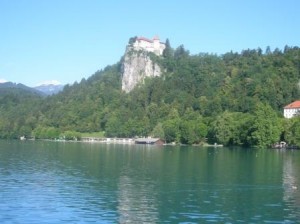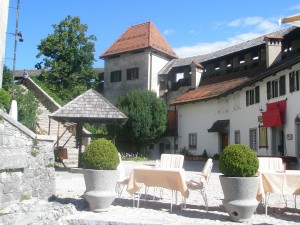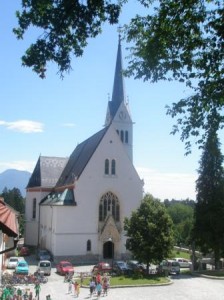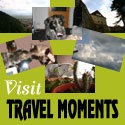Bled, the fairy-tale castle
Read Part 1 about lake Bled.
I reach the land again and I start my ascension to the castle. I have already visited a few medieval citadels such as Salzburg, Warwick or Sao Jorje, so to my mind I would not be impressed. I am wrong: climbing the mountain to the palace proves to be a difficult one, on a narrow path, deep in the woods.
 I get on the top and I am bewildered: the view is one of the most beautiful I have ever seen. The emerald lake lies at my feet in the shape of a raindrop distinguishing itself from the pasture of green forests. And here I begin the story. A single tower was rising on the cliff in 1004-1011, when Bled Castle (Veldes coming from an old German word meaning “stone”) was first mentioned in the chronicles in relation to the German king Henry 2nd offering it to the Bishop Albuin of Brixen and his church. It is considered to be the oldest Slovenian castle and it has been constantly growing since then, being expanded through new buildings in Renaissance and baroque styles after having fallen under the Habsburg domination. The castle celebrates this year its 1000th anniversary and concerts, fireworks and simulations of medieval life are organized.
I get on the top and I am bewildered: the view is one of the most beautiful I have ever seen. The emerald lake lies at my feet in the shape of a raindrop distinguishing itself from the pasture of green forests. And here I begin the story. A single tower was rising on the cliff in 1004-1011, when Bled Castle (Veldes coming from an old German word meaning “stone”) was first mentioned in the chronicles in relation to the German king Henry 2nd offering it to the Bishop Albuin of Brixen and his church. It is considered to be the oldest Slovenian castle and it has been constantly growing since then, being expanded through new buildings in Renaissance and baroque styles after having fallen under the Habsburg domination. The castle celebrates this year its 1000th anniversary and concerts, fireworks and simulations of medieval life are organized.
 There are several must-see attractions that immerse me in the various eras of the castle. First of all, the printing house stores an old Gutenberg printing machine and some examples of an early Slovenian Bible. This is of particular interest for me as communication practitioner and researcher, so I take a closer look to the odd old machinery that was once used also for printing the German and Slavic stories that have made out of Prince Tepes a bloody hero. The room is dedicated to Primoz Trubar, a Slovene protestant that has written the first printed book in Slovenian and contributed to the consolidation of the Slovene language. Next, there is a cellar with refined Slovenian wines. I am greeted by a parrot, the friend of the monk who explains me that Slovenia has various wine-yards, and even if it is not a mass-producer, it has high-quality sorts. It’s worth trying! Also, the baroque 17th century Chapel consecrated to bishops St. Albuin and to St. Ingenium enchants your eyes with illusionist frescoes.
There are several must-see attractions that immerse me in the various eras of the castle. First of all, the printing house stores an old Gutenberg printing machine and some examples of an early Slovenian Bible. This is of particular interest for me as communication practitioner and researcher, so I take a closer look to the odd old machinery that was once used also for printing the German and Slavic stories that have made out of Prince Tepes a bloody hero. The room is dedicated to Primoz Trubar, a Slovene protestant that has written the first printed book in Slovenian and contributed to the consolidation of the Slovene language. Next, there is a cellar with refined Slovenian wines. I am greeted by a parrot, the friend of the monk who explains me that Slovenia has various wine-yards, and even if it is not a mass-producer, it has high-quality sorts. It’s worth trying! Also, the baroque 17th century Chapel consecrated to bishops St. Albuin and to St. Ingenium enchants your eyes with illusionist frescoes.
After having experienced the terrace which offers romantic views over the lake and the church I talk to some Australian tourists in love with Europe and especially with Bled. Next step is the interior of the Castle. The different chambers offer information about the genealogy of the lake, the history of Slovenia and the castle itself. There is a travel machine I can say: numerous simulations and virtual museums, mannequins and information on the lifestyle of people (jewels, coins, arms, pottery) transport me in different époques. What I enjoy most is a room with a 3D simulation of the lake and video information on its geomorphologic and historical evolution and a calendar including old Slovenian beliefs about the nature of Time. Just before leaving, I have an interesting talk with the Museum’s curator and the director of the National Museum of Slovenia about which I will update you later. But I will stop here with the disclosures. It is still so much to see that I will leave you, my readers, to dig for the rest!
 Later, I discover the pathway to the lake and make a last stop in the Parish Church, consecrated to St. Martin, built in 1905 on the site of a previous 15th century Gothic church whose original chapel had been erected before the year 1000. It includes a mix of baroque, Gothic and neo-Gothic and it hosts Carrara marble statues and also much of the original paintings that have been restored together with works of great Slovenian architects and designers.
Later, I discover the pathway to the lake and make a last stop in the Parish Church, consecrated to St. Martin, built in 1905 on the site of a previous 15th century Gothic church whose original chapel had been erected before the year 1000. It includes a mix of baroque, Gothic and neo-Gothic and it hosts Carrara marble statues and also much of the original paintings that have been restored together with works of great Slovenian architects and designers.
Finally, I arrive on the shore of the lake with the feeling of having visited a world of centuries ago that has miraculously survived, protected by the spirit of the lake. It is a must-live adventure that I am sure all of you would enjoy!

I love old castles!
Thanks for the comment!:) Hopefully you enjoyed this castle. You can check the others on the blog as well :).